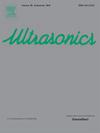Ultrasonic transmission of longitudinal modes in miniaturized cylindrical waveguides
IF 3.8
2区 物理与天体物理
Q1 ACOUSTICS
引用次数: 0
Abstract
This study investigates the transmission and reflection of axisymmetric longitudinal L(0,) modes in miniaturized cylindrical waveguides. The theoretical framework developed herein focuses on the analysis of the propagation of longitudinal modes within a homogeneous, elastic, and isotropic cylindrical waveguide with a varying cross-section. The novelty of this paper is found in the energy calculations and the consideration of higher-order modes for accurately describing the transmission and reflection coefficients at waveguide transitions. A 2D axisymmetric Finite Element Method (FEM) is used to calculate these coefficients based on the modal energy of propagating modes across different frequencies. The influence of geometrical and material properties, along with modal density, is examined numerically. Results demonstrate that optimal transmission occurs when the wavenumber ratio of propagating modes in connected waveguides is an integer, leading to effective coupling. Experimental validation on steel rods with diameters from 4 mm to 0.8 mm shows strong agreement with numerical results. It is observed that the L(0,1) mode around 1 MHz is the most suitable mode for efficient transmission between the waveguides. In contrast, the higher-order modes (L(0,2) around 1.25 MHz, L(0,3) between 1.3 and 1.5 MHz, and L(0,4) from 2.25 MHz) exhibit weak or irregular transmission, with more pronounced reflection behaviors, indicating that they are not optimal for efficient transmission in this configuration. These findings underline the importance of an optimized geometric transition in enhancing the transmission efficiency in such miniaturized waveguides.
微型化圆柱波导中纵向模态的超声传输
本文研究了轴对称纵向L(0,n)模在小型化圆柱波导中的透射和反射。本文发展的理论框架侧重于分析纵向模式在具有不同横截面的均匀、弹性和各向同性圆柱波导中的传播。本文的新颖之处在于能量计算和考虑高阶模式以准确描述波导跃迁处的透射和反射系数。利用二维轴对称有限元法(FEM),根据不同频率上传播模态的模态能量来计算这些系数。几何和材料特性的影响,以及模态密度,进行了数值研究。结果表明,当连通波导中各传播模式的波数比为整数时,传输效果最佳,从而实现有效耦合。对直径为4 ~ 0.8 mm的钢棒进行了实验验证,结果与数值结果吻合较好。结果表明,1 MHz左右的L(0,1)模式是波导间有效传输的最合适模式。相比之下,高阶模式(1.25 MHz附近的L(0,2), 1.3和1.5 MHz之间的L(0,3),以及2.25 MHz附近的L(0,4))表现出微弱或不规则的传输,具有更明显的反射行为,表明它们不是该配置下有效传输的最佳选择。这些发现强调了优化几何跃迁对提高这种小型化波导的传输效率的重要性。
本文章由计算机程序翻译,如有差异,请以英文原文为准。
求助全文
约1分钟内获得全文
求助全文
来源期刊

Ultrasonics
医学-核医学
CiteScore
7.60
自引率
19.00%
发文量
186
审稿时长
3.9 months
期刊介绍:
Ultrasonics is the only internationally established journal which covers the entire field of ultrasound research and technology and all its many applications. Ultrasonics contains a variety of sections to keep readers fully informed and up-to-date on the whole spectrum of research and development throughout the world. Ultrasonics publishes papers of exceptional quality and of relevance to both academia and industry. Manuscripts in which ultrasonics is a central issue and not simply an incidental tool or minor issue, are welcomed.
As well as top quality original research papers and review articles by world renowned experts, Ultrasonics also regularly features short communications, a calendar of forthcoming events and special issues dedicated to topical subjects.
 求助内容:
求助内容: 应助结果提醒方式:
应助结果提醒方式:


